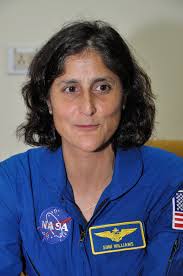 Sunita Williams
Sunita Williams
Sunita Lyn "Suni" Williams née Pandya [1] (born September 19, 1965) is a former American astronaut and a United States Navy officer. She holds the records for
longest single space flight by a woman (195 days), total spacewalks by a woman (seven), and most spacewalk time for a woman (50 hours, 40 minutes).
Williams was assigned to the International Space Station as a member of Expedition 14 and Expedition 15. In 2012, she served as a flight engineer on Expedition 32 and then commander of Expedition 33.
Early Life:
Sunita Williams was born in Euclid, Ohio, to Indian American neuroanatomist Deepak Pandya and Slovene American Ursuline Bonnie Pandya, who have three children and reside in Falmouth, Massachusetts. Sunita is the youngest of three siblings, her brother Jay Thomas is four years older and her sister Dina Anna is three years older.
Williams’ paternal ancestry is from Jhulasan, Mehsana district in Gujarat, India while her maternal great grandmother Mary Bohinc (originally Marija Bohinjec), born 5 September 1890 in Leše, immigrated to America as an eleven year old girl with her mother, an 1891 Slovene emigrant Ursula Bohinc née Strajhar.
Williams graduated from Needham High School in Needham, Massachusetts, in 1983. She received a Bachelor of Science degree in Physical science from the United States Naval Academy in 1987, and a Master of Science degree in Engineering Management from Florida Institute of Technology in 1995.
Military career
Williams was commissioned an ensign in the United States Navy in May 1987. After a six-month temporary assignment at the Naval Coastal System Command, she was designated a Basic Diving Officer. She next reported to the Naval Air Training Command, where she was designated a Naval Aviator in July 1989. She received initial H-46 Sea Knight training in Helicopter Combat Support Squadron 3 (HC-3), and was then assigned to Helicopter Combat Support Squadron 8 (HC-

in Norfolk, Virginia, with which she made overseas deployments to the Mediterranean, Red Sea and the Persian Gulf for Operation Desert Shield and Operation Provide Comfort. In September 1992, she was the Officer-in-Charge of an H-46 detachment sent to Miami, Florida, for Hurricane Andrew relief operations aboard the USS Sylvania. In January 1993, Williams began training at the U.S. Naval Test Pilot School. She graduated in December, and was assigned to the Rotary Wing Aircraft Test Directorate as an H-46 Project Officer and V-22 chase pilot in the T-2. Later, she was assigned as the squadron Safety Officer and flew test flights in the SH-60B/F, UH-1, AH-1W, SH-2, VH-3, H-46, CH-53, and the H-57. In December 1995, she went back to the Naval Test Pilot School as an instructor in the Rotary Wing Department and as the school's Safety Officer. There she flew the UH-60, OH-6, and the OH-58. She then went to the USS Saipan as the Aircraft Handler and the Assistant Air Boss. Williams was deployed on the Saipan in June 1998 when she was selected by NASA for the astronaut program.
She has logged more than 3,000 flight hours in more than 30 aircraft types.
NASA career
Astronaut Sunita L. Williams, Expedition 14 flight engineer, participates in the mission's third planned session of extravehicular activity (EVA).
Williams began her Astronaut Candidate training at the Johnson Space Center in August 1998. It included orientation briefings and tours, numerous scientific and technical briefings, intensive instruction in Space Shuttle and International Space Station systems, physiological training and ground school to prepare for T-38 flight training, as well as learning water and wilderness survival techniques.
Following training and evaluation, Williams worked in Moscow with the Russian Space Agency on the Russian contribution to the ISS, and with the first expedition crew sent to the ISS. After Expedition 1 returned, Williams worked in the Robotics branch on the ISS Robotic Arm and the related Special Purpose Dexterous Manipulator. She was a crew member on the NEEMO 2 mission, and lived underwater in the Aquarius habitat for nine days in May 2002.
In 2008, Williams served as NASA's Deputy Chief of the Astronaut Office.She was assigned as a backup crew member for Expedition 30 to the International Space Station, was a crew member of Expedition 32, which launched in July 2012, and then became the Commander of Expedition 33, which began in September 2012.
Like many astronauts, Williams is a licensed amateur radio operator, having passed the technician-class license exam in 2001, and was issued the call sign KD5PLB by the Federal Communications Commission on August 13, 2001. She used one of the two amateur radio stations aboard the ISS when she talked with school children.
In 2009, Williams appeared on the The Colbert Report to announce that "Tranquility" was the winning name for Node 3 of the ISS.
